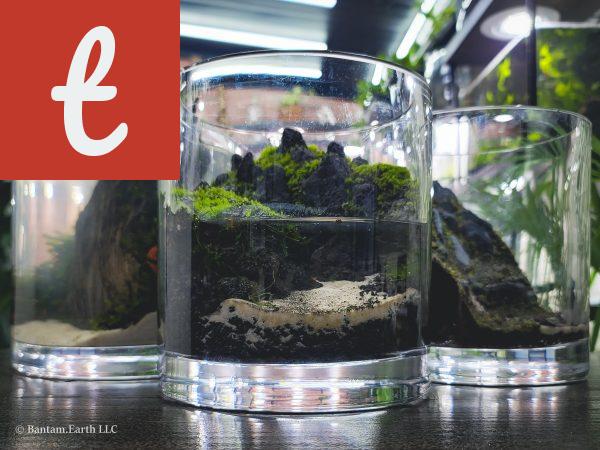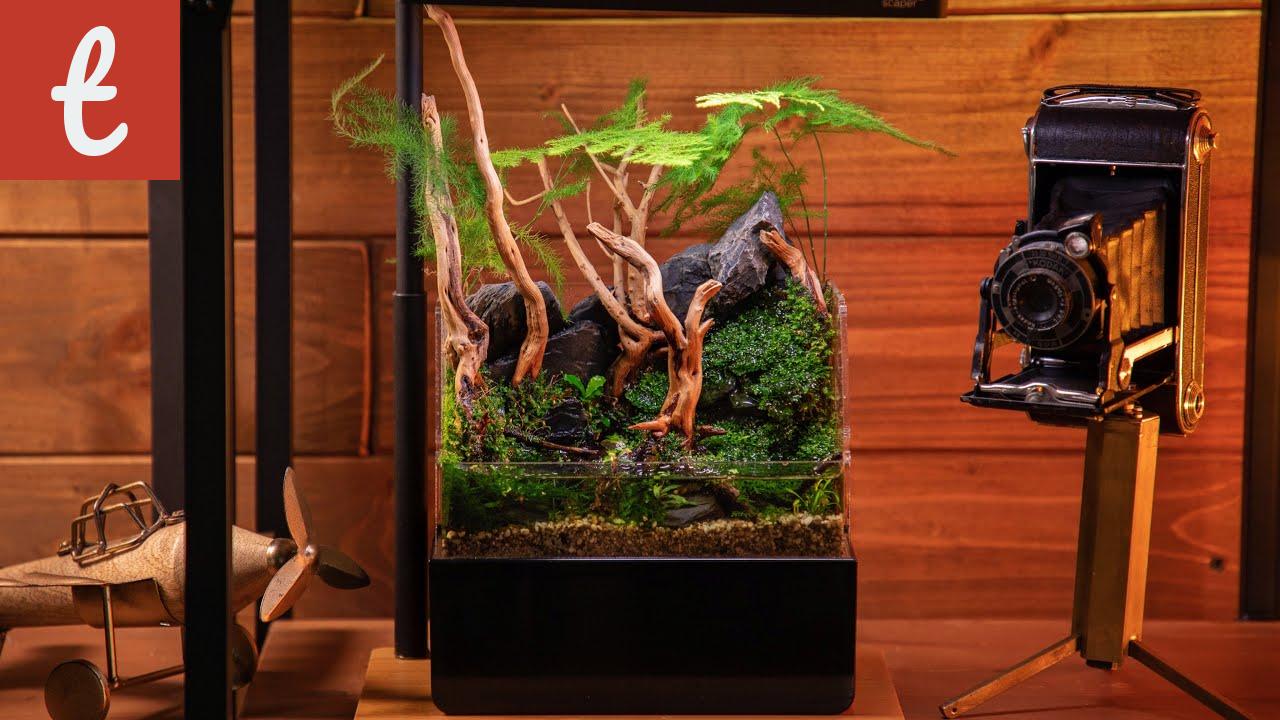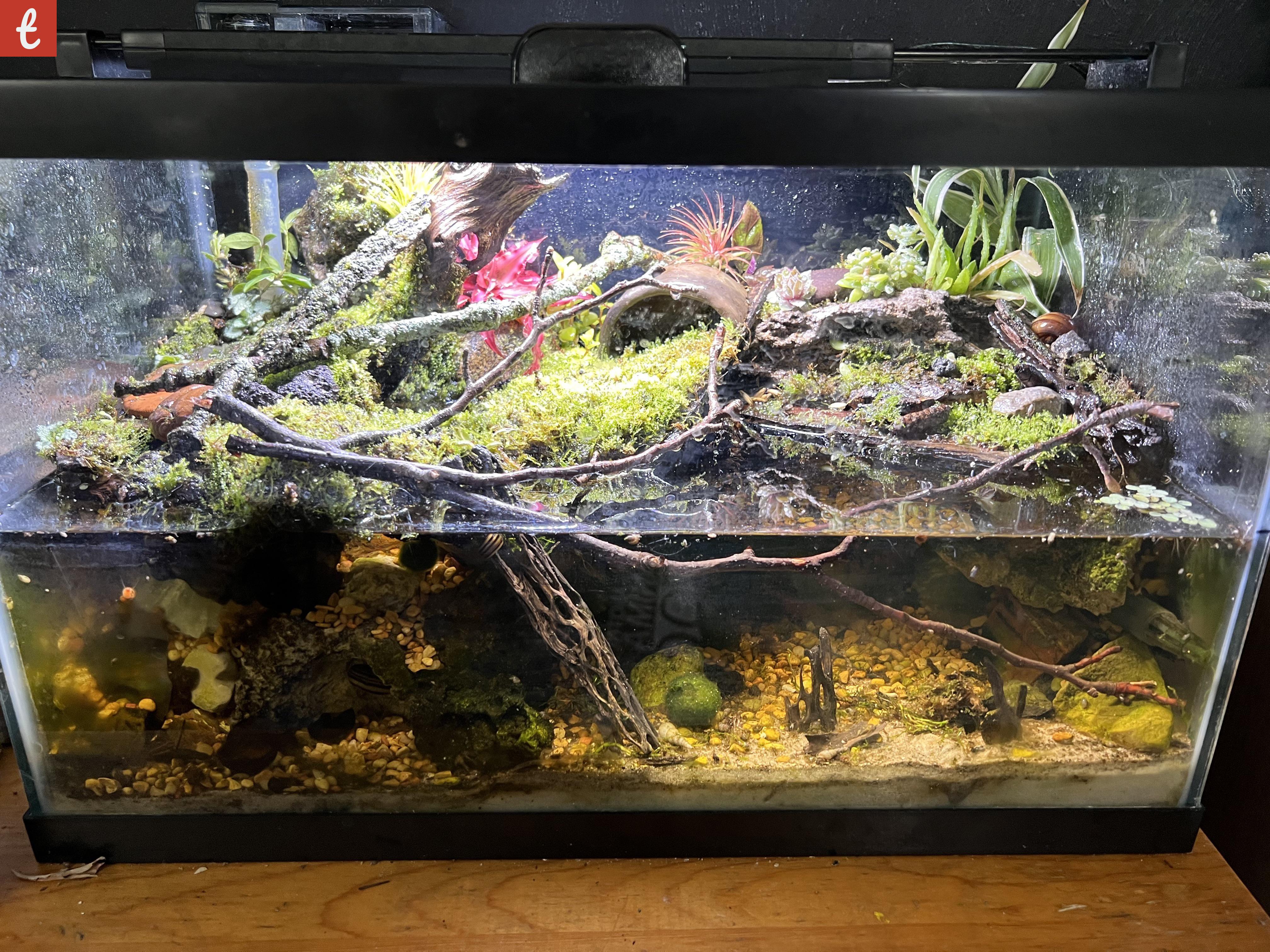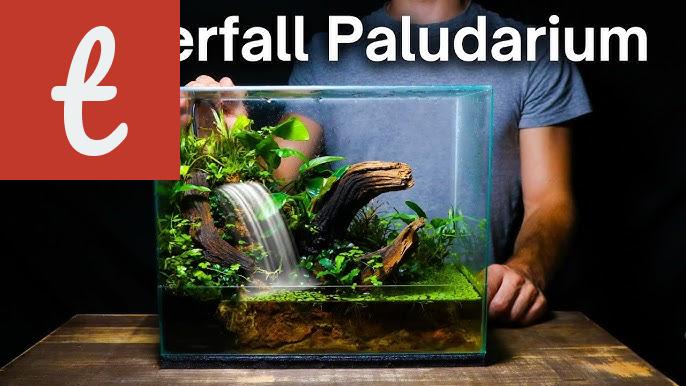Creating the Smallest Paludarium
If you have a passion for nature but limited space in your home, why not try creating a paludarium? A paludarium is a unique and visually appealing combination of an aquarium and a terrarium. It creates a miniature ecosystem that can house aquatic and terrestrial plants, along with small animals like frogs and turtles. In this step-by-step guide, we will walk you through the process of creating the smallest paludarium.
1. Choose the Right Container:
The first step in creating a paludarium is finding the right container. Opt for a small and shallow glass or plastic aquarium that can hold water as well as provide enough space for your plants and animals. Ensure that it has a secure lid to prevent any escape attempts by your pets.
2. Set Up the Aquatic Environment:
Now it's time to set up the aquatic portion of your paludarium. Start by adding a layer of gravel at the bottom of the container to provide a stable base for your plants. Fill the container with water, making sure it covers about one-third of the total height.
Next, select aquatic plants that thrive in both submerged and emerged environments. Consider adding plants like Java fern, Anubias, or Cryptocoryne that can tolerate the transitional conditions of a paludarium.
3. Create the Terrestrial Environment:
The other two-thirds of your container will be dedicated to the terrestrial environment. Begin by adding a layer of well-drained soil suitable for plants. You can use a mix of peat moss, potting soil, and sand to create a nutrient-rich substrate.
Now it's time to choose your favorite terrestrial plants. Look for plants that are adaptable and can tolerate the high humidity levels found in a paludarium. Some great options include mosses, ferns, and small orchids.
- List item 1: Make sure to arrange the plants in a visually pleasing manner. You can create different levels by using rocks, driftwood, or cork bark.
- List item 2: Add a spray bottle to your maintenance kit, as paludariums often require misting to maintain the humidity levels necessary for the plants to thrive.
4. Introducing Animals:
Now that your paludarium is ready, it's time to add some small animals. Research which species are suitable for the size of your container and can coexist harmoniously. Consider adding small frogs, turtles, or even insects like snails or shrimp.
Remember, it is vital to create a suitable environment for your pets. Provide hiding spots, ample food, and regular water changes to ensure their well-being. Additionally, monitor the water temperature and lighting conditions to maintain a healthy balance between the aquatic and terrestrial elements.
5. Maintenance and Care:
Paludariums require regular maintenance to keep them healthy and aesthetically pleasing. Monitor the water quality and make necessary adjustments. Trim and prune the plants as needed to maintain their shape and prevent overgrowth.
Conclusion:
Creating a paludarium is a fantastic way to bring nature into your home, even if you have limited space. By following this step-by-step guide, you can create your own miniature ecosystem. So, gather your supplies, pick your favorite plants and animals, and get ready to embark on an exciting journey into the world of paludariums!
Main Title
Creating a miniature paludarium is a wonderful way to bring a slice of nature into your home, even if you have limited space. Paludariums are unique and versatile enclosures that combine both aquatic and terrestrial elements, allowing you to create a small ecosystem for plants, animals, and even fish. Whether you are a seasoned aquarium enthusiast or a beginner looking for a new project, here are some DIY tips to help you set up the smallest paludarium.
- List item 1: Choose the perfect container
- List item 2: Create a suitable environment
When creating a miniature paludarium, the first step is to choose the right container. Opt for a small transparent glass or acrylic tank that can hold water and is big enough to accommodate the plants and animals you plan to include. Make sure the container has a lid or cover to control the humidity and prevent animals from escaping.
To create a suitable environment for your paludarium, you need to replicate a natural habitat. Start by adding a layer of drainage material at the bottom, such as small pebbles or gravel, to prevent waterlogging. On top of the drainage layer, add a layer of substrate suitable for both plants and animals. This could include a mix of potting soil, coco coir, and sphagnum moss. Ensure that the substrate is moist but not waterlogged.
Next, select the plants and animals that will thrive in a small enclosure. Choose miniature and compact plants that prefer high humidity and can tolerate both moist and dry conditions. Some good options include mosses, ferns, and small orchids. As for the animals, consider small amphibians like tree frogs or newts, or even small fish that can adapt to the size of the tank.
To maintain the health of your paludarium, it is important to control the temperature and humidity levels. Use a small heater or a heat mat to provide warmth, and a humidifier or misting system to maintain the desired humidity. Monitor these levels regularly to ensure they are within the recommended range for the plants and animals in your setup.
Create a visually appealing and natural-looking setup by adding rocks, driftwood, and other decorative elements to mimic a natural environment. These will not only provide hiding spots for your animals but also add aesthetic value to your paludarium.
Conclusion: With a little planning and creativity, you can easily set up a miniature paludarium that fits even the smallest space. Choose the right container, create a suitable environment, select the right plants and animals, and maintain the necessary temperature and humidity levels. By following these DIY tips, you can create a beautiful and thriving miniature paludarium in your home.
The Art of Designing a Tiny Paludarium
Are you looking to bring a slice of nature into your home or office space? Consider designing a tiny paludarium! A paludarium is a unique type of vivarium that combines both land and water elements, creating a perfect habitat for various plants, animals, and even aquatic creatures. Whether you are a beginner or an experienced hobbyist, designing a tiny paludarium can be a rewarding and creative endeavor.
Before diving into the design process, it's essential to understand the various components that make up a paludarium. A tiny paludarium typically consists of a water feature, such as a small pond or aquarium, and a land area where plants and other terrestrial species can thrive. The key to a successful paludarium design lies in finding the right balance between these two elements.
- Water Feature: The water feature is the heart of a paludarium. You can choose to create a small pond using a glass container or even use a compact aquarium. Ensure that the water feature is watertight and has a secure lid to prevent any accidents or escapees.
- Land Area: The land area is where you can let your creativity flourish. Use a mix of different substrates, such as soil, sand, and rocks, to create varying elevations and texture. This will allow for a more diverse range of plant species to be incorporated into your tiny paludarium.
Once you have the basic components in place, it's time to select suitable plants and animals for your tiny paludarium. The type of plants and animals you choose will depend on the size of your paludarium, the light and humidity levels, and your personal preferences. Here are a few factors to consider:
- Size: Opt for smaller plants and animals that can comfortably live in the limited space of a tiny paludarium. Look for compact and slow-growing plants that won't overpower the landscape.
- Lighting: Consider the lighting requirements of the plants you choose. Some species thrive in bright, indirect light, while others prefer low-light conditions. Utilize LED lights or grow lights to provide the necessary illumination for your paludarium.
- Temperature and Humidity: It's crucial to maintain suitable temperature and humidity levels for the plants and animals in your paludarium. Research the specific requirements of the species you plan to keep and invest in a reliable thermometer and hygrometer to monitor these conditions.
- Compatibility: Ensure that the plants and animals you select are compatible with each other. Some species may have different habitat requirements or may not get along with certain animals. Do thorough research and consult with experts if needed.
As you design and set up your tiny paludarium, keep in mind that maintenance is key. Regularly trim and prune the plants to prevent overgrowth and maintain the desired aesthetic. Check and adjust water levels, temperature, and humidity on a regular basis to ensure the well-being of your plants and animals. Regular cleaning and water changes are also essential to maintain water quality.
With a little patience and creativity, designing a tiny paludarium can be an incredibly rewarding experience. It allows you to connect with nature, exercise your design skills, and create a tranquil and captivating piece of living art. So go ahead, embrace the art of designing a tiny paludarium!

Main Title: Compact Paludarium: Building a Small Oasis
If you are a nature lover but lack space in your home, a compact paludarium can be a perfect solution. A paludarium is a unique type of vivarium that combines a terrestrial habitat with an aquatic one. It allows you to create a miniature ecosystem that replicates the conditions found in a natural rainforest.
Building a compact paludarium may seem like a daunting task, but with a little patience and creativity, you can create a small oasis right in your living room. Here are some steps to get you started:
- Choose a Suitable Container: The first step is to select a container that will serve as the foundation for your paludarium. You can use a glass terrarium, an aquarium, or even a repurposed fish tank. Just ensure that it is watertight and has a lid to maintain the humidity.
- Create the Aquatic Area: The next step is to set up the aquatic area. Make sure to use an appropriate substrate such as gravel or aquatic soil. Add water to the container, ensuring that the depth is suitable for your desired aquatic plants and any potential fish or aquatic animals you may want to include.
Now comes the fun part – designing the terrestrial area. Consider adding rocks, driftwoods, and plants to mimic a natural rainforest environment. Choose plants that thrive in high humidity and low light conditions, such as ferns, mosses, and bromeliads. These plants will create lush greenery and provide shelter for any future inhabitants.
To maintain the optimal conditions for your paludarium, it is important to provide the right amount of light, heat, and humidity. Install a suitable lighting system, such as LED grow lights, to provide adequate light for both the terrestrial and aquatic plants. Use a hygrometer to monitor the humidity levels and incorporate a misting system if necessary.
Lastly, to add life to your paludarium, consider adding small aquatic creatures like freshwater shrimp or small fish. These tiny inhabitants will add movement and vitality to your ecosystem. Remember to research their specific requirements regarding food, water temperature, and compatibility.
A compact paludarium is not only a beautiful addition to your home decor but also a miniature escape into nature. It is a mesmerizing mix of land and water that brings the tranquility and beauty of a rainforest to your fingertips. Whether you observe the inhabitants or simply enjoy the ambiance, your compact paludarium will surely become a conversation starter and an oasis of relaxation in your home.
Creating a Nano Paludarium: Size Doesn't Matter
When it comes to paludariums, the word "nano" might make you think of something small and insignificant. However, don't be fooled by its name! Nano paludariums can be just as beautiful and captivating as their larger counterparts.
What exactly is a paludarium, you ask? Well, it's a unique combination of an aquarium and a terrarium. This type of setup allows you to create a mini ecosystem with both aquatic and terrestrial elements. In essence, it's like bringing a piece of nature right into your home.
When it comes to setting up your nano paludarium, you might be limited by space constraints. But don't worry, as they say, "size doesn't matter." Even with a smaller size, you can still create a stunning and functional paludarium that will mesmerize anyone who sees it.
- Choose the right container: The first step in creating your nano paludarium is selecting an appropriate container. A glass tank or a clear acrylic container works best, as it allows for easy viewing of your mini ecosystem. Make sure it has a lid or cover to maintain humidity and prevent excess evaporation.
- Think vertical: With limited horizontal space, it's crucial to make use of the vertical space in your nano paludarium. Incorporate different levels or tiers, using rocks, driftwood, or other natural materials. This will provide your plants and animals with various areas to explore and thrive.
Now it's time to bring in the plants and animals that will inhabit your nano paludarium. It's essential to choose species that are suitable for the size of your setup and can coexist harmoniously. Look for small aquatic plants like java moss, anubias, or dwarf hairgrass that can be attached to rocks or driftwood. For terrestrial plants, consider mosses, ferns, or small orchids.
When it comes to animals, opt for small, peaceful species that won't outgrow your paludarium. Some popular choices include shrimp, snails, small aquatic frogs, or even tiny dart frogs if you have a bit more space. Creating a balance between plants and animals will ensure a thriving ecosystem within your nano paludarium.
Nano paludariums can bring a slice of nature into your home, no matter how limited your space may be. By selecting the right container, utilizing vertical space, and choosing suitable plants and animals, you can create a captivating mini ecosystem. Don't underestimate the power of a nano paludarium – size doesn't matter when it comes to beauty and wonder!




Comments on "How To Build The Smallest Paludarium"
No comment found!